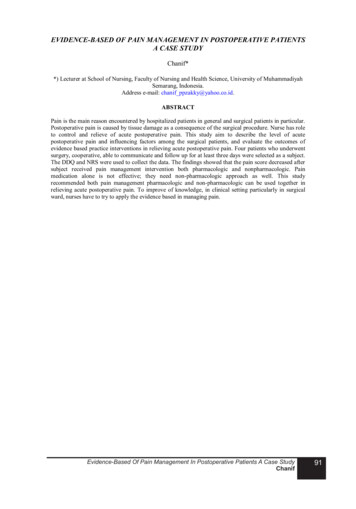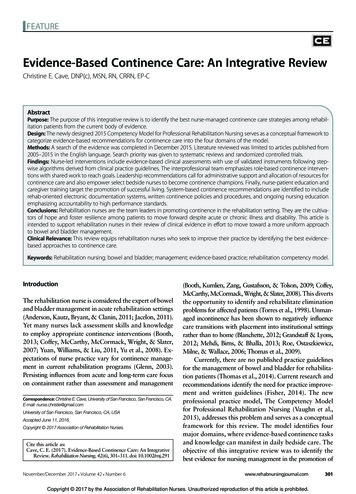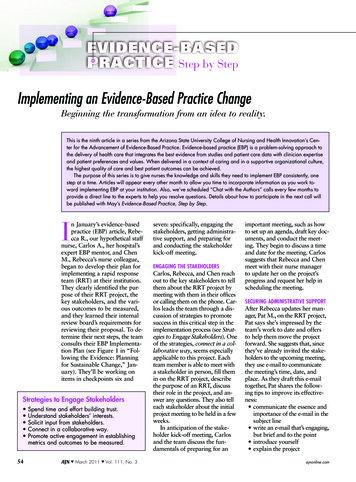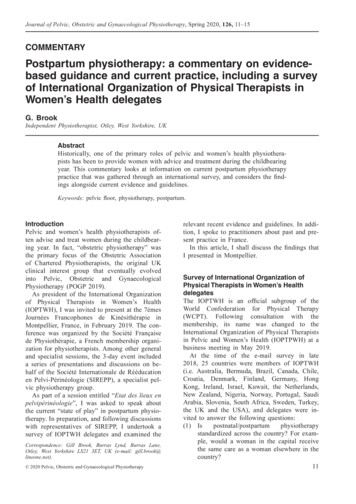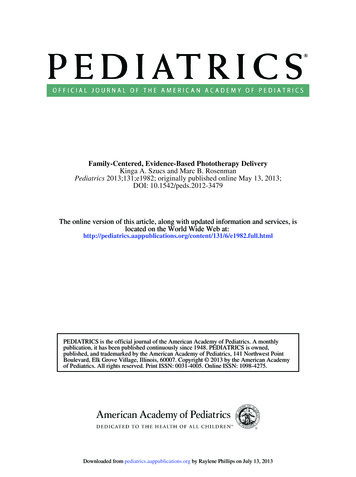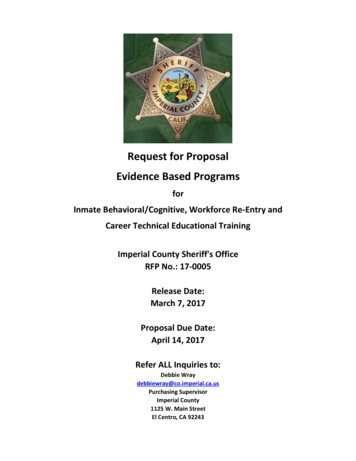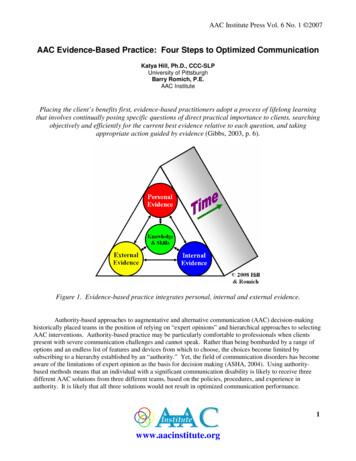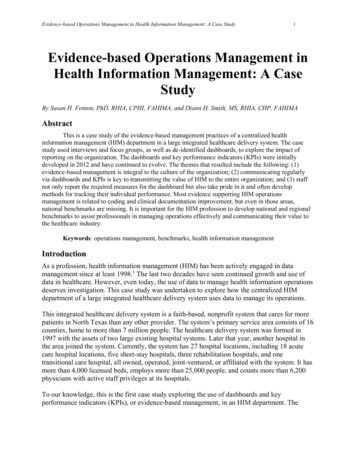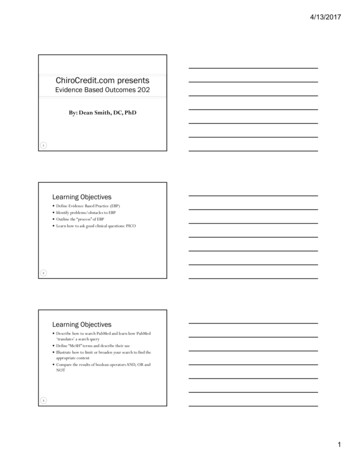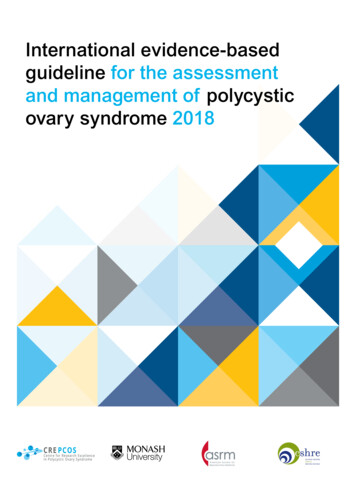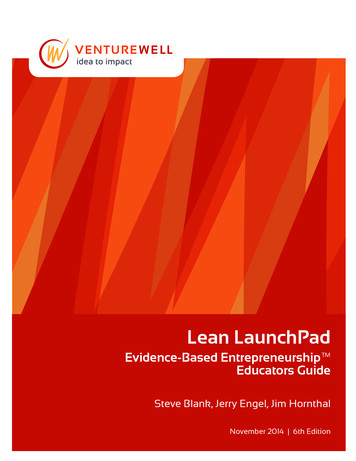
Transcription
Lean LaunchPadEvidence-Based Entrepreneurship Educators GuideSteve Blank, Jerry Engel, Jim HornthalNovember 2014 6th Edition
PrefacePurposeThe goal of this document is to give you the theory of why we created the Lean LaunchPadclass and the practice of how we have run it. However, it is neither a guide nor a cookbook fora class. As educators, we expect you to adapt the class to your own school and curriculum asappropriate.ScopeThe Lean LaunchPad class was developed primarily from graduate level experience at several ofthe nation’s leading universities. It’s been taught both in engineering and business schools, aswell as to post-graduate teams under the National Science Foundation program. However, webelieve the methodology has broader applicability, and it is being adapted for use inundergraduate programs.FocusThe focus of the Lean LaunchPad class has primarily been on scalable startups, often techbased; however, initial indications are that the approach is generalizable and can embrace thechallenges faced by small and medium-sized businesses, as well as new ventures in largecorporations.AcknowledgementsThe Lean LaunchPad was first taught at Stanford University as part of the Stanford TechnologyVentures Program. Hats off to Kathy Eisenhardt and Tom Byers, who gave us the freedom toinvent and teach the class.The class would not have been possible without the two VCs who volunteered their time toteach this Stanford class with me: Jon Feiber of Mohr Davidow Ventures and Ann Miura-Ko ofFloodgate. Lisa Forssell taught the "how to present" class and Thomas Haymore was anindefatigable Teaching Assistant. Thanks also to our team of mentors.At UC Berkeley Haas Business School, Dean Rich Lyons was the Principal Investigator for theNSF Innovation Corps, Toby Stuart and Andre Marquis allowed us to test the class in theirdepartment, and Jerry Engel and entrepreneur/angel investor Jim Hornthal joined the teachingteam.This same group also taught the first NSF Innovation Corps classes, joined by John Burke fromTrue Ventures and Oren Jacob of Toytalk. Under the guidance of Jerry Engel, the FacultyDirector of the NSF’s program, they were joined by teaching teams from University of Michigan,Georgia Tech, University of Maryland, Virginia Tech, GW, City College of New York, Columbia,and NYU. Bhavik Joshi was the TA for both the Berkeley and first NSF classes.At Columbia, Murray Low and my co-author Bob Dorf taught the first five-day version of theclass. At Caltech, thanks to Ken Pickar and Jon Feiber, Andy Sack, and Chuck House.Steve Blank6th edition Nov 20142
Table of eams.27Cross- 12.CourseIterations:10- ‐Week,12- ‐Week,5- ‐Day.39Steve Blank6th edition Nov 20143
10- ‐and12- re- 53StudentAssignment:Pre- 3:PresentationSkillsTraining.134AppendixA:E- ample10- amPresentations.156Pre- e5- LifeSciencesSyllabus.201WhyTakeThisClass?.201Steve Blank6th edition Nov 20144
ics.207Pre- 13Homework.216HomeworkfornextweeksOct14thclass- ‐Activities.218HomeworkfornextweeksOct21stclass- artners.223HomeworkfornextweeksNov4thClass7- ‐Channels.225HomeworkforNov11thClass8- nueandCosts.229AppendixE:ClassRoadmap:9- ment.244StudentPeer- ve Blank6th edition Nov 20145
1. The Lean Startup ManifestoFor the last decade, we’ve been teaching students how to write business plans. They wereuseful: 1) they provided a comprehensive way to help students envision the issues, 2) were apedagogically simple paradigm, and 3) were what venture capitalists required. Yet time andagain we watched as few of those plans survived first contact with customers. It took us sometime until we recognized that business plans suffered from a fatal flaw: they assumed startupswere just smaller versions of large companies. We now know that they’re not.Before the Lean Startup Method started to take hold, conventional wisdom stated that the firstthing a founder must do is create a business plan—a static document that with a series ofimplicit hypotheses describes the size of an opportunity, the problem to be solved, and thesolution that the new venture will provide. Typically it includes a five-year forecast for revenue,profits, and cash flow. A business plan is essentially a research exercise written in isolation at adesk before an entrepreneur has even begun to build a product. The implicit assumption is thatit’s possible to figure out most of the unknowns of a business in advance, before you raisemoney and actually execute the idea.The problem with this process is that tends to build an increasingly false sense of certainty, inan environment that is fundamentally uncertain. In this conventional model, once anentrepreneur with a convincing business plan obtains money from investors, he or she feelscompelled to execute the plan as presented. He or she embarks on developing the product.Developers invest thousands of man-hours to prepare it for launch with little, if any, customerinput. Only after the product is built and launched does the product get substantial feedbackfrom customers—when the sales force attempts to sell it. And too often, after months or evenyears of development, entrepreneurs learn the hard way that customers do not need or wantmost of the product’s features.After decades of watching thousands of startups follow this standard regimen, we’ve nowlearned at least three things: As business plans are full of untested assumptions, they rarely survive first contact withcustomers. As the boxer Mike Tyson once said about his opponents’ prefight strategies:“Everybody has a plan until they get punched in the mouth.”No one, aside from venture capitalists and the former Soviet Union, requires five-yearplans to forecast a series of unknowns. These plans are generally fiction, and conceivingthem is almost always a waste of time.Startups are not smaller versions of large companies. They do not unfold in accordancewith master plans. Those that ultimately succeed go quickly from failure to failure, allthe while adapting, testing new iterations, and improving their initial ideas as theycontinually learn from customers.Existing companies execute a business model, startups search for one. This distinction is at theheart of the Lean Startup approach. It shapes the lean definition of a startup: a temporaryorganization designed to search for a repeatable and scalable business model.Steve Blank6th edition Nov 20146
The Lean Startup: Key PrinciplesFirst, rather than engaging in months of planning and research, entrepreneurs accept that allthey have on day one is a series of untested hypotheses—basically, good guesses. Thefoundation of the Lean Startup is evidence-based entrepreneurship. Instead of creating anintricate business plan, founders summarize their hypotheses in a framework called a BusinessModel Canvas. Essentially, this is a diagram of how a company will create value for itself and itscustomers.Second, Lean Startups use a “get out of the building” approach called Customer Developmentto test their hypotheses and collect evidence about whether they are true or false. They go outand ask potential users, purchasers, and partners for feedback on all elements of the businessmodel, including product features, pricing, distribution channels, and affordable customeracquisition strategies. The emphasis is on nimbleness and speed; new ventures rapidlyassemble minimum viable products (MVPs) and immediately elicit customer feedback. Then,using customers’ input to revise their assumptions, Lean Startups start the cycle over again,testing redesigned offerings and making further small adjustments (iterations) or moresubstantive ones (pivots) to ideas that aren’t working.Third, Lean Startups practice something called agile development, which originated in thesoftware industry. Agile development works hand-in-hand with Customer Development. Unliketypical yearlong product development cycles that presuppose knowledge of customers’problems and product needs, agile development eliminates wasted time and resources bydeveloping the product iteratively and incrementally. It’s the process by which startups createthe minimum viable products they test.Strategy: Business Model to Operating PlanThe emphasis on search for a business model versus execution of a plan is at the heart of theLean LaunchPad curriculum.When first starting a new venture, the business model is unknown.1 It is a set of untestedhypotheses. Startup teams’ key task is to test hypotheses, searching to verify the businessmodel components; e.g., Customer Segments, Value Proposition, product features, gen-and-custdevfit-perfectly.htmlSteve Blank6th edition Nov 20147
pricing, Get/Keep/Grow strategy.2 Once the business model is known, new ventures benefitfrom creating a business plan to determine and communicate how the business will beexecuted.The term “business model” first appeared around 50 years ago, but the concept didn’t catch onuntil the 1990s.3 A business model describes how a company creates, delivers, and capturesvalue. It became common to discuss business models, but without a standard framework andvernacular, confusion reigned. In 2010, when Alexander Osterwalder published his book,Business Model Generation, he provided a visual framework that was sorely needed, and itbecame obvious that the Business Model Canvas was the tool to organize startup hypotheses ina more structured way.4The primary objective of a startup is to validate its business model hypotheses until it finds onethat is repeatable and scalable (it continues to iterate and pivot until it does or runs out oftime/money).5 Then it moves into execution mode. It’s at this point the startup needs abusiness plan, a document that articulates the model, market, competition, operating plan,financial requirements, forecasts, and other well-understood management tools.Process: Customer and Agile Development to Product ManagementYet as powerful as the Business Model Canvas is (a template with the nine blocks of a businessmodel—see Section 3) is, at the end of the day it is just a tool for identifying Challengers/dp/0470876417/ref sr 1 1?s books&ie UTF8&qid 1312200974&sr merdevelopment-stack/3Steve Blank6th edition Nov 20148
without a formal way of testing them.6 The Lean LaunchPad approach extends this process intothe real world by providing a set of tools for testing hypotheses and enhancing the venturethrough experimentation and iteration.The processes used to organize and implement the search for the business model are acombination of Customer Development and agile development.7 The search for a businessmodel can occur in any new business—in a brand-new startup or in a new division of anexisting company.The Customer Development model breaks out all the customer-related activities of an earlystage company into four easy to understand steps. The first two steps outline the “search” forthe business model. Steps three and four “execute” the business model that’s been developed,tested, and proven in steps one and two. The steps: Customer Discovery first captures the founders’ vision and turns it into a series of businessmodel hypotheses. Then it develops a plan to test customer reactions to those hypothesesand turn them into facts.Customer Validation tests whether the resulting business model is repeatable and scalable.If not, the team returns to Customer Discovery.Customer Creation is the beginning of execution. It builds end-user demand and drives itinto the sales channel to scale the business.Company building transitions the organization from a startup to a company focused onexecuting a validated model.In the “search” steps, teams want a process designed to be dynamic, so they will work with arough business model description knowing it will change. The business model changesbecause startups use Customer Development to run experiments to test their hypotheses thatmake up their business model (first testing their understanding of the customer problem, andthen their proposed solutions). Most of the time, these experiments fail. Search embracesfailure as a natural part of the startup process. Unlike existing companies that fire executiveswhen they fail to match a plan, the Lean Startup keeps the founders and fires the hypothesesby changing the business model.Organization: Customer Development Team to Functional OrganizationOnce a company has found a business model (meaning that it knows its market, customers,product/service, channel, pricing, etc.), the organization “graduates” from startup status andmoves from search mode to execution.In an existing business, the product execution process—managing the lifecycle of existingproducts and the launch of follow-on products—is the job of the product management andengineering organizations.8 It results in a linear process where teams make operating plans andrefine them into detail. The more granularity added to a plan, the better people can execute it:a Business Requirement Document9 (BRD) leads to a Market Requirements Document (MRD),6789http://en.wikipedia.org/wiki/Business Model Canvashttp://www.stevenblank.com/startup index qty.htmlhttp://en.wikipedia.org/wiki/Product managementhttp://en.wikipedia.org/wiki/Business requirementsSteve Blank6th edition Nov 20149
which then gets handed off to engineering as a Functional Specifications Document10 (FSD)implemented via Agile or Waterfall development.The search for a business model requires a different organization from the one used to executea plan.11 Searching requires the company to be organized around a Customer DevelopmentTeam led by the founders. Only the founders can make the strategic decisions to iterate and/orpivot the business model, and to do that they need to hear customer feedback directly. Incontrast, execution (which follows search) assumes that the job specifications for each of thesenior roles in the company can be tightly defined. Execution most often requires a company tobe organized by function (product management, sales, marketing, business development, etc.).Companies in execution often suffer from a “fear of failure culture,” quite understandable sincethe executives were hired to execute a known job spec.12 In contrast, successful new ventureshave Customer Development Teams have a “learning and discovery” culture that thrives on thesearch process. The fear of making a move before every last detail is nailed down is one of thebiggest problems that existing companies have when they try to implement a “search” process.The idea of not having a functional organization until the organization has found a provenbusiness model is one of the hardest things for most new startups (and most early stageinvestors) to grasp. There are no sales, marketing, or business development departments al spec itles-that-can-sink-your-startup/Ibid.Steve Blank6th edition Nov 201410
you are searching for a business model. If you’ve organized your startup with thosedepartments, you are not really doing Customer Development. (It’s like trying to implement astartup using Waterfall engineering.)Education: Search to ExecutionEntrepreneurship as an academic discipline is only a few decades old. They were first taught aselectives and are now part of core business school curricula. However, the field is still strugglingto escape from the bounds of the business plan-centric view that startups are “smaller versionsof a large company.” Venture capitalists who’ve watched as no startup business plan survivedfirst contact with customers continue to insist that startups write business plans as the price ofentry to venture funding. This continues to be the case even as many of the best VCsunderstand that business “planning,” and not the “plan”
The Lean Startup: Key Principles First, rather than engaging in months of planning and research, entrepreneurs accept that all they have on day one is a series of untested hypotheses—basically, good guesses.

